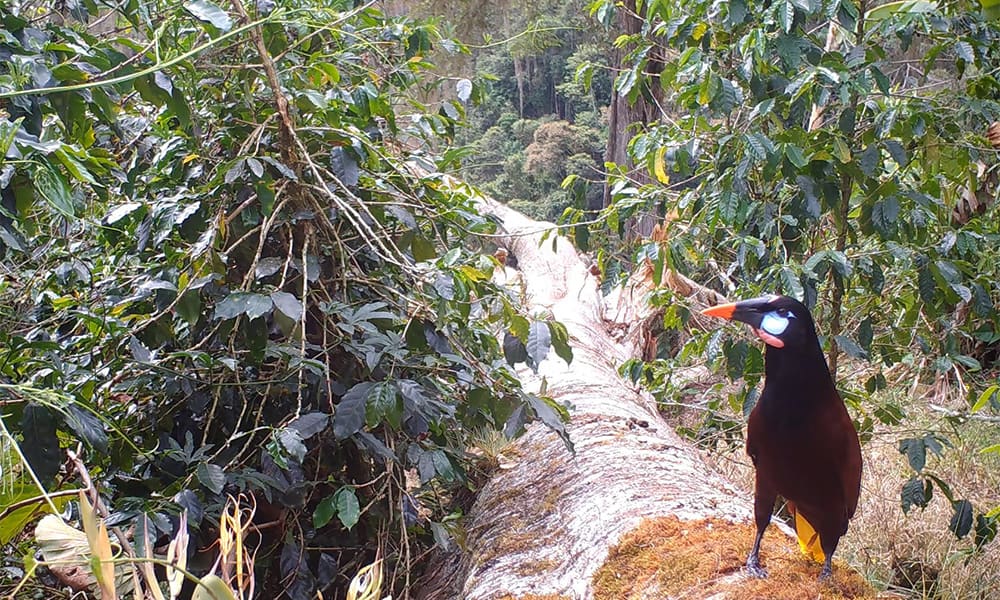‘What am I hearing?’ That will most likely be your initial reaction to your first Montezuma oropendola interaction.
I can distinctly remember the first time I heard one. I was new to Costa Rica, and my wife and I were visiting new friends who had a house around Lake Arenal. I was already elated with my first toucan sightings and while gazing into the trees that dotted the foreground of a picturesque view of the lake, I heard it.
It’s exceedingly difficult to describe bird noises in text but I think I can get the point across by describing it as a melodious gurgle with a metallic scratchiness to it that makes you think it may have emanated from a robot. You’ll have to look up the call on the internet, it’s well worth a listen.
The Montezuma oropendola (Psarocolius Montezuma) is known as the oropéndola de Moctezuma in Spanish. At some point in the last few years I looked up the Spanish name to make sure I wasn’t saying something crazy when I was conversing about this particular bird with Tico colleagues. Just as most people just say oropendola in English, most people say oropéndola in Spanish, you just need to put the emphasis on the ‘e.’
At the time, I also noticed that Montezuma was changed to Moctezuma in the Spanish name and I thought, ‘That’s silly. Why did they slap that ‘c’ in there in Spanish?’ Now, looking it up again, I see that the species is named for the Aztec emperor Moctezuma II. I suppose the English name is the one that needs work.
I find oropendolas to be very attractive birds. Their bodies are mostly black/chesnut, they have bright yellow tails, the tip of their long beak is orange, and their faces are highlighted with blue patches on the cheeks and below that a kind of pink waddle. The males and females have the same coloration, but males are much larger than females.
Montezuma oropendolas can be found throughout the northern parts of Costa Rica, through the Central Valley, the Caribbean, and in the more humid parts of northern Guanacaste. Though they tend to nest in isolated trees out in the open, they readily enter the forest to search for food.
They usually travel in small flocks, foraging within the forest and on its edges, as well as agricultural areas and people’s gardens. They’re omnivorous. They’ll happily eat fruit and drink nectar from flowers. They’ll also poke, prod, and pry their way through vegetation looking for invertebrates and small vertebrates.
Their nests are a sight to behold. They are colonial breeders. Females are responsible for weaving a 2 to 6 foot long, teardrop shaped pouch out of vines and plant fibers, which they attach to the end of a branch high in the tree. There are typically around 30 nests in a colony but there can be many more.
Luckily for us, the trees that they choose for their colonies are out in the open, often on the side of the road, making it easy for bird lovers to pull over and marvel at the sight of the many long brown nests dripping off of the branches of the tall tree.
I see, and hear, Montezuma oropendolas frequently when I’m working within their range. I’ve only recorded them a few times with my camera traps. The most memorable videos were recorded in a project on the Aquiares coffee farm. We placed a camera trap on a fallen tree in the middle of a field amongst the coffee plants and a small flock of Montezuma oropendolas posed perfectly for the camera while inspecting the tree for something to eat. Check out those videos and a few others in the video below.
About the Author
Vincent Losasso, founder of Guanacaste Wildlife Monitoring, is a biologist who works with camera traps throughout Costa Rica. Learn more about his projects on facebook or instagram. You can also email him at: vincent@guanacastewildlifemonitoring.com

